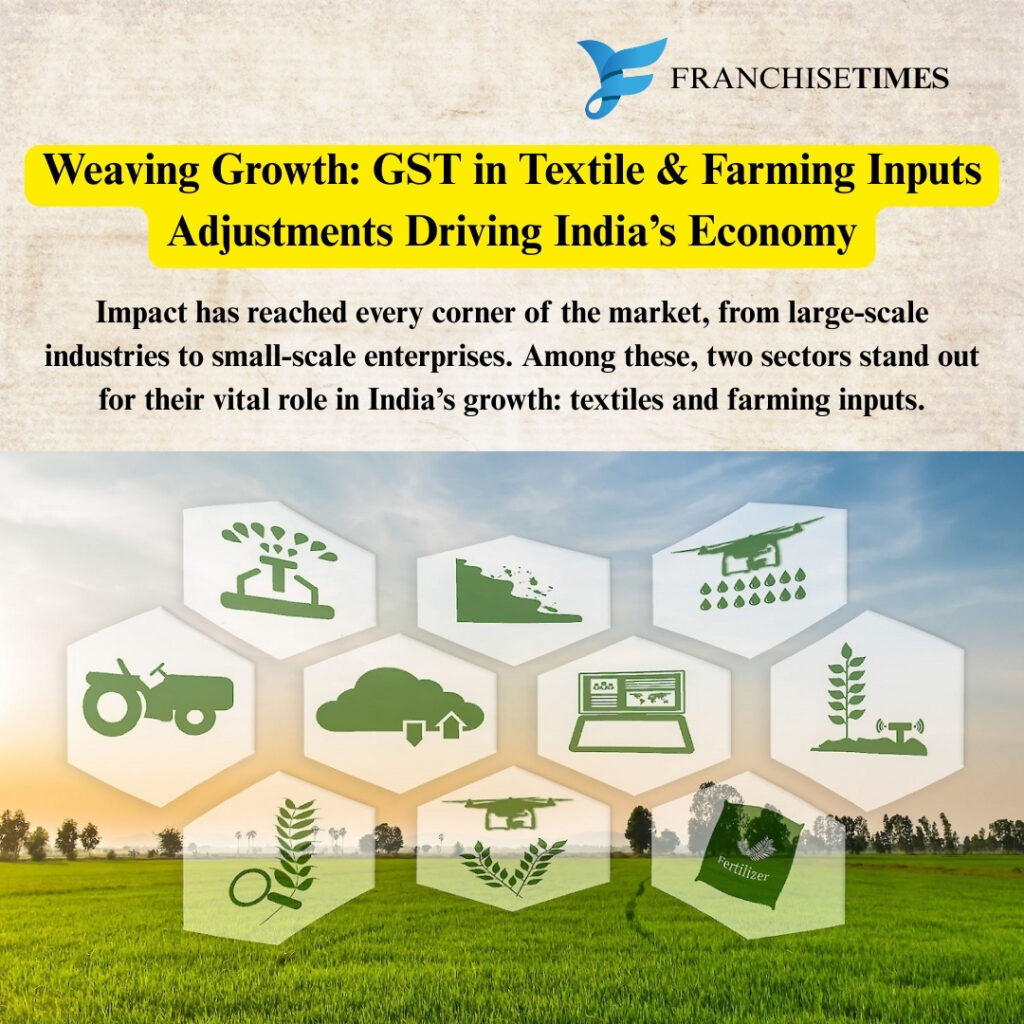Weaving Growth: GST in Textile & Farming Inputs Adjustments Driving India’s Economy
The Goods and Services Tax (GST) has been one of the most significant economic reforms in India. Its impact has reached every corner of the market, from large-scale industries to small-scale enterprises. Among these, two sectors stand out for their vital role in GST in textile farming growth.
Both industries are deeply connected with the lives of millions. The textile sector is India’s second-largest employer after agriculture, while farming inputs like fertilizers, seeds, pesticides, and machinery fuel agricultural productivity. Any changes in taxation directly influence these areas, affecting costs, pricing, and livelihoods.

This blog provides a detailed look at GST in textile & farming inputs adjustments. It explains how recent reforms are reshaping business practices, reducing burdens, and creating opportunities. By the end, you will understand how GST aligns with India’s vision of economic inclusivity and sustainable growth.
GST in Textile & Farming Inputs Adjustments: An Overview
The GST regime replaced a complicated tax system with a single, unified framework. Before GST, textiles and farming inputs were taxed under multiple state and central levies, which created confusion and inefficiencies. The new model brought clarity and uniformity.
In the textile industry, GST rates vary depending on fabric types, garments, and value. For farming inputs, GST rates cover fertilizers, seeds, tractors, and related equipment. However, the government has frequently adjusted these rates to balance affordability with revenue needs.
Key adjustments include:
- Reduction of GST on fertilizers and agricultural equipment to keep farming affordable.
- Rationalization of textile rates to avoid inverted duty structures.
- Introduction of exemptions for essential items like seeds.
- Encouragement of exports by offering input tax credits.
These adjustments show the government’s effort to maintain both affordability for consumers and competitiveness for businesses.
How GST Adjustments Impact the Textile Industry
The textile sector is diverse, ranging from cotton farmers to garment exporters. It employs over 45 million people directly and contributes significantly to India’s GDP. GST in textile & farming inputs adjustments has transformed this industry in several ways.
Simplified Taxation Structure
Earlier, textiles faced a web of excise, VAT, and entry taxes. Now, GST has replaced them with a unified system. This shift has reduced compliance burdens, making it easier for small and medium enterprises (SMEs) to operate.
Input Tax Credit Advantage
Manufacturers can now claim credits for taxes paid on raw materials like cotton, yarn, and dyes. This ensures fair taxation and reduces cascading costs. Consequently, exporters benefit as their products become more competitive in global markets.
Rate Rationalization
The government introduced specific GST rates to balance affordability. For example:
- Cotton garments below ₹1,000 attract 5% GST.
- Garments above ₹1,000 fall under 12%.
- Man-made fiber fabrics are taxed at 12%.
These structured rates help maintain stability across different product categories.
Boost for Organized Retail
With GST compliance, unorganized players are gradually moving towards formalization. This transition boosts transparency, reduces black-market activities, and helps in building brand credibility.
Challenges in Transition
Despite advantages, certain issues remain. Small weavers often struggle with digital compliance. Additionally, the initial inverted duty structure led to higher input taxes than output taxes, locking up working capital. Recent adjustments have addressed these concerns, but more fine-tuning is still needed.
GST and Its Influence on Farming Inputs
Agriculture sustains nearly half of India’s population. Farmers depend on inputs like seeds, fertilizers, pesticides, and machinery. Any tax burden on these essentials directly affects food production and rural incomes. GST in textile & farming inputs adjustments plays a critical role here.
Fertilizers and Pesticides
Initially, GST on fertilizers was set at 12%. This created concerns as it increased farming costs. Responding to feedback, the government reduced GST on fertilizers to 5%. Pesticides, however, remain taxed at 18%, which still adds pressure on farmers.
Seeds and Irrigation Equipment
Seeds are exempt from GST, recognizing their essential role. Irrigation equipment and drip systems fall under 12%, encouraging adoption of modern techniques without making them unaffordable.
Tractors and Farm Machinery
Farm machinery like tractors attracts 12% GST. Though higher than the earlier VAT in some states, farmers can now claim input tax credits, which balances costs in the long run.
Benefits for Farmers
- Affordable fertilizers and exempted seeds reduce cultivation expenses.
- Organized supply chains minimize black marketing of inputs.
- Reduced transport costs due to unified tax system benefit rural markets.
Challenges Farmers Face
- Compliance requirements may not be farmer-friendly.
- Input suppliers pass GST costs to farmers, especially for pesticides.
- Lack of awareness among small farmers about credits and benefits.
The government continues to adjust rates, aiming to strike a balance between farmers’ affordability and industry growth.
Economic Impact of GST Adjustments
The adjustments in GST in textile & farming inputs extend beyond taxation. They create ripple effects throughout the economy.
Employment Growth
Both sectors are labor-intensive. Lower input costs and simplified taxation encourage businesses to expand, creating more jobs for rural and urban populations alike.
Boost to Exports
With uniform taxation and input credit benefits, Indian textiles have become more competitive in global markets. Similarly, efficient farming inputs support higher productivity, strengthening India’s position as an agricultural exporter.
Formalization of Businesses
GST compliance reduces tax evasion and pushes unorganized players into the formal sector. This helps expand the tax base and increases government revenue without burdening end-users.
Encouragement of Innovation
Lower rates on machinery and irrigation systems encourage investment in advanced technologies. Farmers adopt modern practices, and textile manufacturers upgrade machinery, improving efficiency.
Inflation Control
Tax adjustments on essential goods like fertilizers and fabrics prevent inflationary pressures. This keeps daily necessities affordable for households across India.
Future Outlook: GST in Textile & Farming Inputs Adjustments
Looking ahead, GST will continue to evolve. Both textiles and farming inputs will remain focus areas for reforms. Policymakers are considering further steps to ensure inclusivity and growth.
Likely future adjustments include:
- Lowering GST on pesticides to reduce farmers’ input costs.
- Further rationalization of textile rates to eliminate remaining duty inversions.
- Introduction of digital support systems for small weavers and farmers.
- Special relief packages during inflationary cycles for essential goods.
- Incentives for eco-friendly farming and sustainable textile production.
These measures will align with India’s vision of doubling farmers’ income and expanding the textile industry’s global footprint.
Conclusion
The introduction and continuous reform of GST in textile farming growth have brought immense changes to these crucial sectors. From simplifying taxes to boosting exports, the benefits are clear. Farmers enjoy cheaper inputs, while textile players gain input tax credit advantages and structured rates. Challenges remain, but reforms are ongoing to create balance.
As India aims to strengthen its economy, textiles and farming will stay at the core. With GST evolving as a flexible system, both industries are poised for growth. The ultimate beneficiaries will be farmers, workers, entrepreneurs, and consumers—proving that taxation reforms, when carefully designed, can weave prosperity across the nation.
